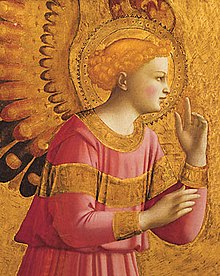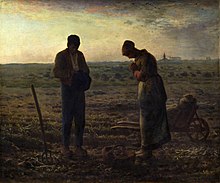The angel of the lord

The Angel of the Lord , also called the Angelus after its Latin beginning , is a prayer that is said morning, noon and evening. It is named after his first words: Latin Angelus Domini nuntiavit Mariæ ... 'The angel of the Lord brought the message to Mary ...'
The angelus is usually rung as an invitation to prayer . The prayer includes the meditative contemplation of the Incarnation of God , preceded by the preaching of the Archangel Gabriel to Mary . Each of the three contemplation words from the Gospels of Luke and John is followed by an Ave Maria . The final oration ends the angelus, but the three times doxology honor be to the father and the commemoration of the dead can be added.
In 1742 Pope Benedict XIV arranged for the Regina caeli to be prayed instead of the Angel of the Lord during Easter .
The Pope publicly prays the Angelus (or Regina caeli) every Sunday and on solemn festivals at 12 noon from the window of the papal apartment in the Apostolic Palace (or from Castel Gandolfo ) and then gives the Apostolic Blessing . This is broadcast from the Centro Televisivo Vaticano not only via satellite, but also on large screens in St. Peter's Square .
history
The shape of the angelus that is common today has developed step by step. The momentum for the introduction of the evening ringing came from the Franciscan order , as the General Chapter of the Order in Pisa in 1263 under the direction of St. Bonaventure recommended to guide the faithful at the evening ringing for Compline the Blessed Mother to greet and the incarnation of God to remember because Mary heard the message of the Archangel Gabriel in the evening and received Jesus . In the 14th century, the morning bell came into use, originally accompanying a prayer for the public good and peace. It was then reinterpreted in 1423 by the particular councils in Cologne and Mainz as “a reminder of the pain of Mary at the Passion of Christ ”.
The noon bells came up again almost a century later: in 1456 Pope Calixt III ordered. to ring the bell at noon for a prayer for a victory of the Hungarian-Serbian troops in Belgrade against the besieging Turks. This was maintained after the victory of the Christian troops on July 22, 1456. It merged with the differently motivated morning and evening bells since, under the influence of the Jesuits in the 17th century, the interpretation that the morning bells reminded of the resurrection of Jesus Christ , the midday bells of his passion on the cross and the evening bells of the incarnation of Christ became decisive .
It now became customary to pray the Marian antiphon Regina caeli in the morning , the Responsorium Tenebrae factae sunt at noon , dum crucifixissent Jesum Judaei and in the evening three times the Ave Maria , for which Pope John XXII. granted an indulgence . The Angelus prayer in its current form was approved by Pope Pius V in 1571 , the final oration, which expresses the entire redemption event of the Incarnation, death and resurrection of Jesus Christ, was added later.
For religious who could not pray the Latin choral prayer , it had the function of a regular hour prayer in addition to other prayers .
text
| German | Latin |
|---|---|
|
The angel of the Lord brought the message to Mary |
Angelus Domini nuntiavit Mariae |
Individual evidence
- ↑ Alberich M. Altermatt OCist: Circular 6 from the secretary of the OCist secretariat for liturgy to the monasteries of the order . Eschenbach, 2006
- ↑ Andreas Heinz : Angelus . In: Walter Kasper (Ed.): Lexicon for Theology and Church . 3. Edition. tape 1 . Herder, Freiburg im Breisgau 1993, Sp. 653 f .
- ↑ Andreas Heinz: Angelus . In: Walter Kasper (Ed.): Lexicon for Theology and Church . 3. Edition. tape 1 . Herder, Freiburg im Breisgau 1993, Sp. 653 f .
- ↑ Andreas Heinz : Angelus . In: Walter Kasper (Ed.): Lexicon for Theology and Church . 3. Edition. tape 1 . Herder, Freiburg im Breisgau 1993, Sp. 653 f .
